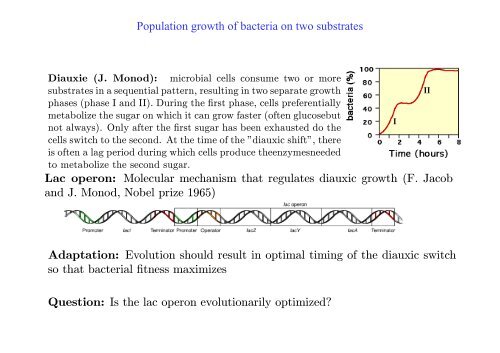The Lotka-Volterra predator-prey model
The Lotka-Volterra predator-prey model
The Lotka-Volterra predator-prey model
Create successful ePaper yourself
Turn your PDF publications into a flip-book with our unique Google optimized e-Paper software.
Population growth of bacteria on two substrates<br />
Diauxie (J. Monod):<br />
microbial cells consume two or more<br />
substrates in a sequential pattern, resulting in two separate growth<br />
phases (phase I and II). During the first phase, cells preferentially<br />
metabolize the sugar on which it can grow faster (often glucosebut<br />
not always). Only after the first sugar has been exhausted do the<br />
cells switch to the second. At the time of the ”diauxic shift”, there<br />
is often a lag period during which cells produce theenzymesneeded<br />
to metabolize the second sugar.<br />
Lac operon: Molecular mechanism that regulates diauxic growth (F. Jacob<br />
and J. Monod, Nobel prize 1965)<br />
Adaptation: Evolution should result in optimal timing of the diauxic switch<br />
so that bacterial fitness maximizes<br />
Question: Is the lac operon evolutionarily optimized?
















